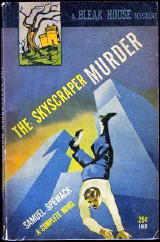Thu 8 Aug 2013
Reviewed by William F. Deeck: SAMUEL SPEWACK – The Skyscraper Murder.
Posted by Steve under Authors , Reviews[5] Comments
William F. Deeck
SAMUEL SPEWACK – The Skyscraper Murder. Macaulay, hardcover, 1928; Bleak House #17, no date [1947/48?].

When the reader is informed by the publisher that the writer of a mystery is also the author of “a long list of Broadway and Hollywood hits,” some nervousness about the quality of the mystery may be aroused. In this instance it is definitely justified.
An alleged bridge expert, Oliver Sewell has four closets in his apartment devoted to female attire for his four lovers of the moment and his lovers, he hopes, to be. After having attended a nightclub with one of his paramours and her former husband, Sewell is found shot dead in his apartment.
His body, although he was killed elsewhere, had been placed in a chair three feet from a mirror. Sewell should not have been in his apartment, dead or alive, because he was not seen returning from the nightclub, nor could his killer have escaped without being noticed.
The butler reports having served meals for two, although no one lived with Sewell. A Sewell paramour is spotted coming out of a concealed room. Do the authorities scratch their heads puzzledly, then exclaim “Eureka!” and search for another hidden passages? Nope.
The assistant medical examiner, who aids the police detective in the case, tells the detective that Sewell had been dead two hours. “That means — if it means anything — Sewell was killed just before midnight, ha?” the detective asks brightly. The doctor does not disagree.
A short while later it is confirmed that Sewell had been in a nightclub at 1:00 a.m. Any consternation on the part of the doctor or the detective? Nope. It turns out that the murder took place about 2:00 a.m. and that this mistiming is merely the author’s bewilderment.
The gun used to kill Sewell was taken from Sewell’s business associate while he was sleeping at Sewell’s apartment. It was employed in the dirty work and then returned to the associate in the hope of framing him. When the associate discovers that his gun was the murder weapon, he gets rid of it. Nonetheless, when another character is shot, the bullet, according to the police laboratory, came from the original gun.
Possible, you say; yet the killer in his confession mentions in passing that he had his own revolver and that he used it, not the original pistol, to shoot the second victim. Show biz has obviously taken its toll on our author.
Under the name of Leonard Slater, Sewell had planned to sail to Europe with one of his lovers. Later the killer goes to Europe on that same ship, and he cunningly uses the name of Leonard Slater. Why? Otherwise our fine pair of detectives would still be nonplussed.
Another completely absurd plot development takes place, but to describe it in all its inanity would be giving away who the killer was. And there may be someone who cares, although it would be hard to understand why.
Bibliographic Note: According to Al Hubin’s Crime Fiction IV, Samuel Spewak was the author of one other work of detective fiction: Murder in the Gilded Cage (Simon & Schuster, 1929). Based on the novel was a film entitled Secret Witness (Columbia, 1931). For more on the author himself, his Wikipedia entry can be found here.
August 9th, 2013 at 10:26 am
I KNEW I knew the name Spewack — he wrote Kiss Me Kate. Hard to believe he was also responsible for this. It sounds like a convoluted mess.
August 9th, 2013 at 1:42 pm
Reading about the Spewacks did not make me like them. Kiss Me Kate was extremely effective. Am almost sorry abut that.
August 9th, 2013 at 5:14 pm
Kelly and Barry
Can’t say as I’d disagree with either of you. As a matter of fact, I don’t!
— Steve
August 10th, 2013 at 7:21 pm
“Did Spewack get better with his next book?,” asked Mike Tooney as a member of Yahoo’s Golden Age of Detection group.
He then answered his own question:
MURDER IN THE GILDED CAGE.
By Samuel Spewack.
Simon & Schuster. 1929. $2.00
Full review:
“A SENSATION-LOVING divorcee, Mrs. Breese, departs
for Cuba on her yacht, taking a family group and guests.
She is murdered in ‘the gilded cage’, her palatial Havana
home, in a singularly cunning manner. Perutkin, a Russian
adventurer, seeking to clear the name of a friend, leads the
Breese party a merry chase and apprehends the murderer
with a brilliant piece of strategy. A plausible yarn, packed
with excitement and rich in colorful description.”
– Unsigned
– “Notes on New Books”
– THE BOOKMAN
– November 1929
– http://www.unz.org/Pub/Bookman-1929nov-x00146?View=PDFPages
– [Jump To page 346]
August 11th, 2013 at 4:41 am
I enjoyed MURDER IN THE GILDED CAGE when I read it 15 years ago. It is fun and soundly crafted.
Cheap hardback reprint cope of MURDER IN THE GILDED CAGE are everywhere in used bookstores.
By contrast, I’ve never seen a copy of THE SKYSCRAPER MURDER. It’s a book I keep meaning to track down and read.